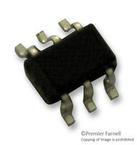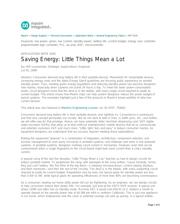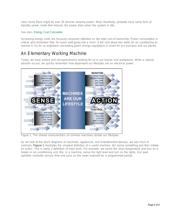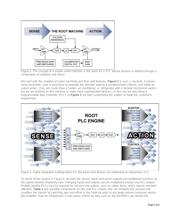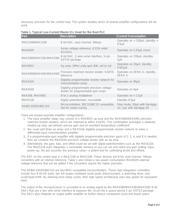下载

Maxim > Design Support > Technical Documents > Application Notes > General Engineering Topics > APP 4335
Keywords: low power, green, low current, standby power, battery life, current budget, energy cost, controller,
programmable logic controller, PLC, op amp, ADC, microcontroller
APPLICATION NOTE 4335
Saving Energy: Little Things Mean a Lot
By: Bill Laumeister, Strategic Applications Engineer
Jul 01, 2009
Abstract: Consumers demand long battery life in their portable devices. Meanwhile for nonportable devices,
increasing energy costs and the latest Energy Star® guidelines are focusing public awareness on wasted
standby power. Thus, meeting green energy regulations and reducing standby power has become designers'
new mantra, especially when systems are active 24 hours a day. To meet the lower power-consumption
levels, circuit designers know that the devil is in the details, with every single circuit required to justify its
current budget. This article shows how Maxim chips can help system designers reduce the power budget of
typical systems. The examples highlight just a few of the products in Maxim's broad portfolio of ultra-low-
current devices.
This article was also featured in Maxim's Engineering Journal, vol. 65 (PDF, 756kB).
Consumers demand long battery life in their portable devices, and rightfully so. Convenience is paramount,
and that very concept permeates our society. We do not want to wait in lines, in traffic jams, etc., and further,
we will often pay for that privilege. Hence, we have automatic teller machines dispensing cash 24/7; digital
video recorders (DVRs) that allow us to time-shift our entertainment; mobile devices that let us communicate
and entertain ourselves 24/7; and much more. "Little, light, fast, and easy" is today's consumer mantra. As
equipment designers, we understand that our success requires meeting those expectations.
Making the equipment "greener" is a combination of integration, architecture, component selection, and
function management to save every microamp in portable systems, and milliamps and more in line-powered
systems. In portable systems, designers routinely count current in microamps. However, even that can be
compromised when a single fingerprint on the circuit board might leak more current than a chip's standby
current.
A popular song of the last five decades, "Little Things Mean a Lot," teaches us how to design circuits for
today's portable market. To paraphrase the song, with apologies to the song writers, "cause honestly, honey,
they just cost" battery. We first think of the big items—a sleeping microprocessor, current-sipping displays,
and flash memories—and then the rest of the circuitry. The devil is in the details, with every supporting circuit
required to justify its current budget. Regulations vary by area, but typical goals for standby power are less
than 0.5W to 3W, while typical goals for operating efficiencies of more than 80% are becoming commonplace.
As a consumer, reading our home utility power bill can be frightening. As an engineer, we can design circuits
to help consumers reduce their power bills. For example, just look at the HDTV DVR receiver. A typical unit
draws 120W and often has no standby mode. Running 24/7, it would cost $34.52 (U.S. dollars) a month to
operate (based on the penalty power rate of $0.399 per kWh in northern California). This is just one appliance
in our home, which emphasizes how the costs or potential savings can add up quickly. In a typical middle-
Page 1 of 6

